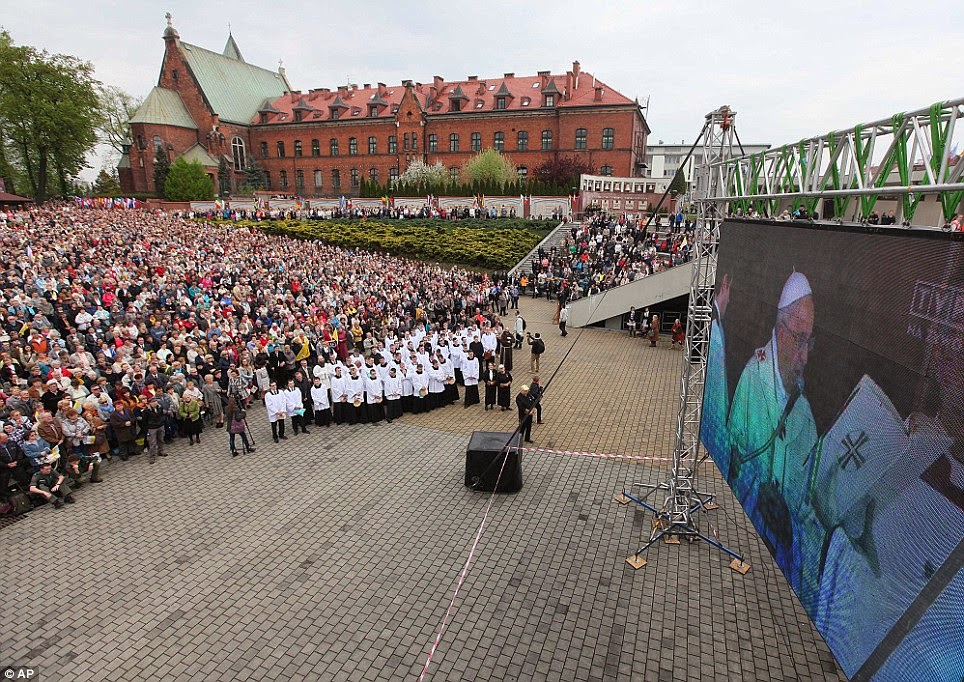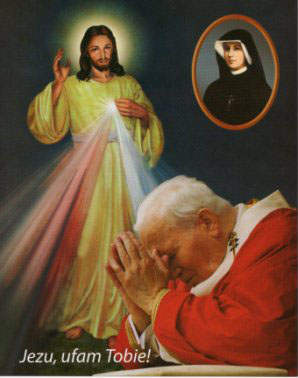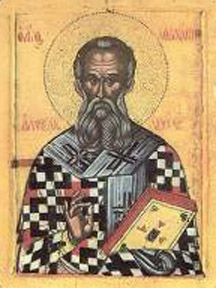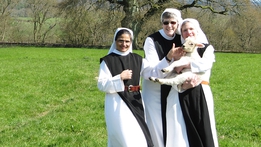 |
| Looking Down: Pope Francis leads the canonisation Mass in which John Paul II and John XXIII are declared Saints |
Sunday, 27 April 2014
Second Sunday of Easter (Divine Mercy Sunday) - Year A
Feast of the Church : Second Sunday of Easter (Divine Mercy Sunday) - Year C
Second Sunday of Easter (Divine Mercy Sunday) - Year C | |||||||||
**********
Divine Mercy Sunday Homily of His Holiness John Paul II Mass in St Peter's Square for the canonization of Sr Mary Faustina Kowalska
Sunday, 30 April 2000
1. "Confitemini Domino quoniam bonus, quoniam in saeculum misericordia eius"; "Give thanks to the Lord for he is good; his steadfast love endures for ever" (Ps 118: 1). So the Church sings on the Octave of Easter, as if receiving from Christ's lips these words of the Psalm; from the lips of the risen Christ, who bears the great message of divine mercy and entrusts its ministry to the Apostles in the Upper Room: "Peace be with you. As the Father has sent me, even so I send you.... Receive the Holy Spirit. If you forgive the sins of any, they are forgiven; if you retain the sins of any, they are retained" (Jn 20: 21-23).
Before speaking these words, Jesus shows his hands and his side. He points, that is, to the wounds of the Passion, especially the wound in his heart, the source from which flows the great wave of mercy poured out on humanity. From that heart Sr Faustina Kowalska, the blessed whom from now on we will call a saint, will see two rays of light shining from that heart and illuminating the world: "The two rays", Jesus himself explained to her one day, "represent blood and water" (Diary, Libreria Editrice Vaticana, p. 132).
2. Blood and water! We immediately think of the testimony given by the Evangelist John, who, when a solider on Calvary pierced Christ's side with his spear, sees blood and water flowing from it (cf. Jn 19: 34). Moreover, if the blood recalls the sacrifice of the Cross and the gift of the Eucharist, the water, in Johannine symbolism, represents not only Baptism but also the gift of the Holy Spirit (cf. Jn 3: 5; 4: 14; 7: 37-39).
Divine Mercy reaches human beings through the heart of Christ crucified: "My daughter, say that I am love and mercy personified", Jesus will ask Sr Faustina (Diary, p. 374). Christ pours out this mercy on humanity though the sending of the Spirit who, in the Trinity, is the Person-Love. And is not mercy love's "second name" (cf. Dives in misericordia, n. 7), understood in its deepest and most tender aspect, in its ability to take upon itself the burden of any need and, especially, in its immense capacity for forgiveness?
Today my joy is truly great in presenting the life and witness of Sr Faustina Kowalska to the whole Church as a gift of God for our time. By divine Providence, the life of this humble daughter of Poland was completely linked with the history of the 20th century, the century we have just left behind. In fact, it was between the First and Second World Wars that Christ entrusted his message of mercy to her. Those who remember, who were witnesses and participants in the events of those years and the horrible sufferings they caused for millions of people, know well how necessary was the message of mercy.
Jesus told Sr Faustina: "Humanity will not find peace until it turns trustfully to divine mercy" (Diary, p. 132). Through the work of the Polish religious, this message has become linked for ever to the 20th century, the last of the second millennium and the bridge to the third. It is not a new message but can be considered a gift of special enlightenment that helps us to relive the Gospel of Easter more intensely, to offer it as a ray of light to the men and women of our time.
3. What will the years ahead bring us? What will man's future on earth be like? We are not given to know. However, it is certain that in addition to new progress there will unfortunately be no lack of painful experiences. But the light of divine mercy, which the Lord in a way wished to return to the world through Sr Faustina's charism, will illumine the way for the men and women of the third millennium.
However, as the Apostles once did, today too humanity must welcome into the upper room of history the risen Christ, who shows the wounds of his Crucifixion and repeats: Peace be with you! Humanity must let itself be touched and pervaded by the Spirit given to it by the risen Christ. It is the Spirit who heals the wounds of the heart, pulls down the barriers that separate us from God and divide us from one another, and at the same time, restores the joy of the Father's love and of fraternal unity.
His message of mercy continues to reach us through his hands held out to suffering man. This is how Sr Faustina saw him and proclaimed him to people on all the continents when, hidden in her convent at £agiewniki in Kraków, she made her life a hymn to mercy: Misericordias Domini in aeternum cantabo.
5. Sr Faustina's canonization has a particular eloquence: by this act I intend today to pass this message on to the new millennium. I pass it on to all people, so that they will learn to know ever better the true face of God and the true face of their brethren.
In fact, love of God and love of one's brothers and sisters are inseparable, as the First Letter of John has reminded us: "By this we know that we love the children of God, when we love God and obey his commandments" (5: 2). Here the Apostle reminds us of the truth of love, showing us its measure and criterion in the observance of the commandments.
It is not easy to love with a deep love, which lies in the authentic gift of self. This love can only be learned by penetrating the mystery of God's love. Looking at him, being one with his fatherly heart, we are able to look with new eyes at our brothers and sisters, with an attitude of unselfishness and solidarity, of generosity and forgiveness. All this is mercy!
To the extent that humanity penetrates the mystery of this merciful gaze, it will seem possible to fulfil the ideal we heard in today's first reading: "The community of believers were of one heart and one mind. None of them ever claimed anything as his own; rather everything was held in common" (Acts 4: 32). Here mercy gave form to human relations and community life; it constituted the basis for the sharing of goods. This led to the spiritual and corporal "works of mercy". Here mercy became a concrete way of being "neighbour" to one's neediest brothers and sisters.
6. Sr Faustina Kowalska wrote in her Diary: "I feel tremendous pain when I see the sufferings of my neighbours. All my neighbours' sufferings reverberate in my own heart; I carry their anguish in my heart in such a way that it even physically destroys me. I would like all their sorrows to fall upon me, in order to relieve my neighbour" (Diary, p. 365). This is the degree of compassion to which love leads, when it takes the love of God as its measure!
It is this love which must inspire humanity today, if it is to face the crisis of the meaning of life, the challenges of the most diverse needs and, especially, the duty to defend the dignity of every human person. Thus the message of divine mercy is also implicitly a message about the value of every human being. Each person is precious in God's eyes; Christ gave his life for each one; to everyone the Father gives his Spirit and offers intimacy.
7. This consoling message is addressed above all to those who, afflicted by a particularly harsh trial or crushed by the weight of the sins they committed, have lost all confidence in life and are tempted to give in to despair. To them the gentle face of Christ is offered; those rays from his heart touch them and shine upon them, warm them, show them the way and fill them with hope. How many souls have been consoled by the prayer "Jesus, I trust in you", which Providence intimated through Sr Faustina! This simple act of abandonment to Jesus dispels the thickest clouds and lets a ray of light penetrate every life. Jezu, ufam tobie.
8. Misericordias Domini in aeternum cantabo (Ps 88 [89]: 2). Let us too, the pilgrim Church, join our voice to the voice of Mary most holy, "Mother of Mercy", to the voice of this new saint who sings of mercy with all God's friends in the heavenly Jerusalem.
And you, Faustina, a gift of God to our time, a gift from the land of Poland to the whole Church, obtain for us an awareness of the depth of divine mercy; help us to have a living experience of it and to bear witness to it among our brothers and sisters. May your message of light and hope spread throughout the world, spurring sinners to conversion, calming rivalries and hatred and opening individuals and nations to the practice of brotherhood. Today, fixing our gaze with you on the face of the risen Christ, let us make our own your prayer of trusting abandonment and say with firm hope: Christ Jesus, I trust in you! Jezu, ufam tobie!
- Copyright © Libreria Editrice Vaticana Blessed John Paul II – the Pope of Divine Mercy | |||||||||
















